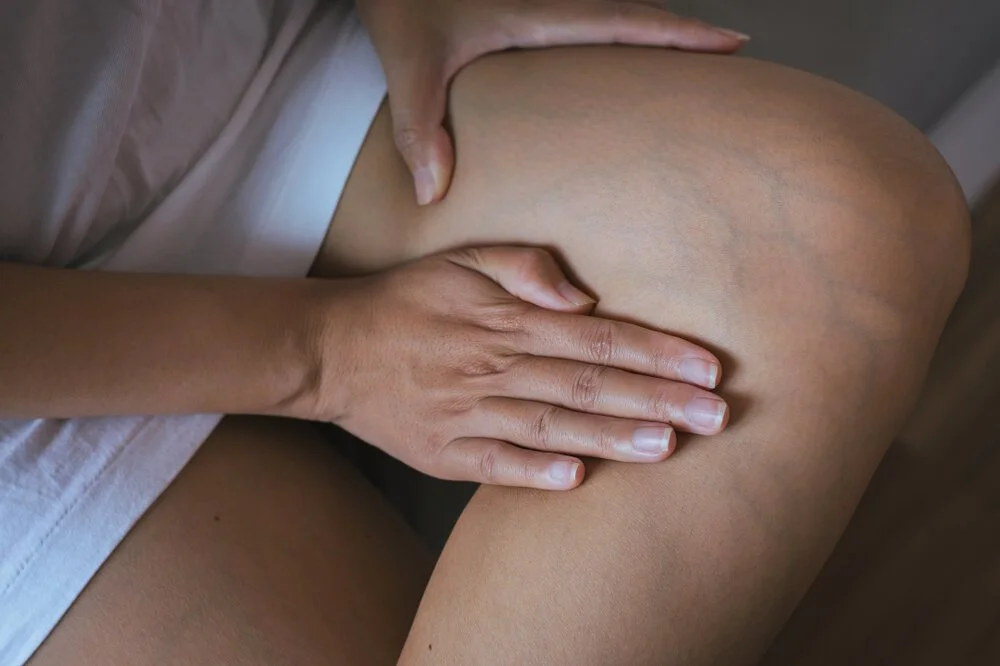Why Are My Veins So Visible?
Veins can suddenly become visible and look as if they are raised under your skin when there is an underlying issue with the way that they are pumping blood back to the heart. You may be worried about your vein health and wonder if you have varicose veins or a serious vein disorder.
There are a variety of reasons for visible veins, but they can indicate a serious underlying vein disease that requires medical attention.
If you notice darker, bulging veins or experience leg swelling, leg heaviness, muscle cramps, itching, and tingling, we recommend a free screening with a vein specialist.
Causes of Visible Veins
Exercise: You may notice visible veins as you work out, which is a good indication of a functional cardiovascular system. For a certain exercise like weight lifting, protruding veins is the result of low BMI.
Skin: People with pale or fair skin tone tend to see more visible veins.
Age: As you age, skin becomes thinner and veins weaken, collecting more pooled blood. The result is larger and more visible veins showing through the skin.
Weight: Having excess weight can put additional pressure on your veins and cause vein problems. On the other hand, if you are underweight or have little body fat, veins are closer to your skin and become more visible.
Family History: If you have a family member with visible veins, the chances are that you might develop them at some point.
Hormones: Hormonal changes or hormonal imbalances can lead to visible veins. During pregnancy, many women notice the appearance of varicose veins and spider veins. This is due to the increased blood volume, extra weight and hormonal changes. Most of the time, visible veins will go away after giving birth.
Weather: In hot weather, the vascular system has to work harder, which causes veins to appear more pronounced.
Prolonged Sitting or Standing: Individuals who have to sit or stand for prolonged periods of time are more likely to develop visible veins.
Vein disease: Vein disease is a common factor that causes varicose veins, and twisted or bulging veins to develop. Varicose veins affect up to 35% of Americans. Varicose veins develop when your blood doesn’t circulate properly and blood starts to pool in your legs. As the blood accumulates, veins darken and bulge, becoming more visible. Besides the visible veins, you may notice symptoms such as swelling, leg cramps, pain, heaviness in your legs. You may also develop symptoms such as swelling, cramps or leg pain, itching, and heaviness in your legs. Many people consider varicose veins as cosmetic issues, but they can develop into serious health issues. It’s highly recommended to seek medical advice if you believe vein disease is the cause of visible veins.
When to Worry About Visible Veins
If you have visible veins and have risk factors of developing vein disease, consult a vein specialist about monitoring and maintaining vein health. You have a high risk if you:
Have a family history of varicose veins
Sit or stand for long hours
Are over the age of 50
Are overweight
Are pregnant
Symptoms associated with varicose veins that you should be worried about:
Spider Veins
Spider veins are tiny, spider-like veins that appear on the legs. Spider veins are an early sign of vein disease.
Varicose Veins
Varicose veins are enlarged, bulging, visible veins above the skin’s surface. Varicose veins can cause significant pain and discomfort. They are accompanied by symptoms including heavy legs, swelling, itching and burning legs.
Blood Clots
Visible veins can develop into blood clots that can be life-threatening. When left untreated, a blood clot can cause a pulmonary embolism. Common symptoms of a blood clot include leg pain, swelling, leg cramps, itching, and burning in the legs.
Skin Discoloration
Vein disease can also cause skin changes besides visible veins. You might notice red or brown spots around your ankles. Skin discoloration, when paired with venous ulcers or slow-healing wounds can put you at risk for serious skin.
Minimally-Invasive Treatment for Unhealthy Visible Veins
Treating Your Varicose Veins
If you notice suddenly visible veins, contact us for a free vein screening. If vein disease is determined as the cause of your visible veins, a variety of minimally invasive procedures can get rid of them. Whether you are concerned about unsightly veins or painful vein conditions, our board-certified vein specialists can help.
At Physicians Vein Clinics, our specialists offer the most advanced procedures that close off faulty veins and reroute blood flow to healthy ones instead. We have 12 convenient vein centers across South Dakota, Iowa, and Minnesota.
Get a free screening with one of our vein specialists to learn about your vein symptoms and treatment options.

